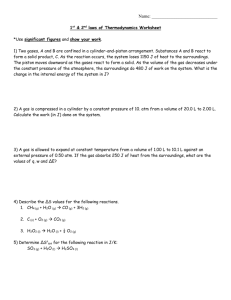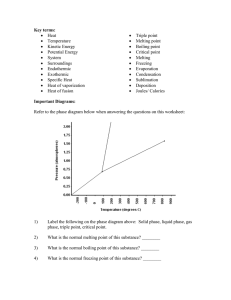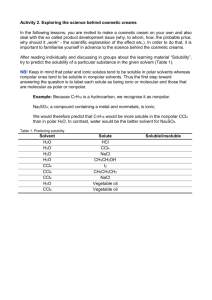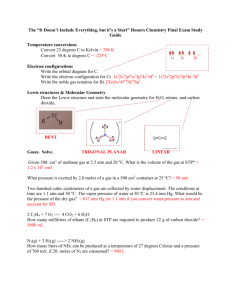12/1
advertisement
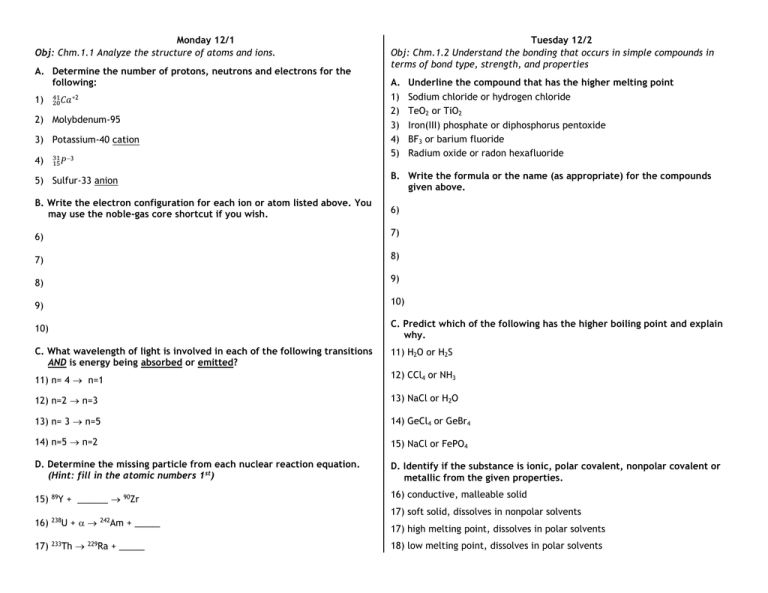
Monday 12/1 Obj: Chm.1.1 Analyze the structure of atoms and ions. A. Determine the number of protons, neutrons and electrons for the following: 1) 41 +2 20𝐶𝑎 2) Molybdenum-95 3) Potassium-40 cation 4) 31 3 15𝑃 Tuesday 12/2 Obj: Chm.1.2 Understand the bonding that occurs in simple compounds in terms of bond type, strength, and properties A. 1) 2) 3) 4) 5) Underline the compound that has the higher melting point Sodium chloride or hydrogen chloride TeO2 or TiO2 Iron(III) phosphate or diphosphorus pentoxide BF3 or barium fluoride Radium oxide or radon hexafluoride 5) Sulfur-33 anion B. Write the formula or the name (as appropriate) for the compounds given above. B. Write the electron configuration for each ion or atom listed above. You may use the noble-gas core shortcut if you wish. 6) 6) 7) 7) 8) 8) 9) 9) 10) 10) C. Predict which of the following has the higher boiling point and explain why. C. What wavelength of light is involved in each of the following transitions AND is energy being absorbed or emitted? 11) H2O or H2S 11) n= 4 n=1 12) CCl4 or NH3 12) n=2 n=3 13) NaCl or H2O 13) n= 3 n=5 14) GeCl4 or GeBr4 14) n=5 n=2 15) NaCl or FePO4 D. Determine the missing particle from each nuclear reaction equation. (Hint: fill in the atomic numbers 1st) D. Identify if the substance is ionic, polar covalent, nonpolar covalent or metallic from the given properties. 15) 89Y + ______ 90Zr 16) conductive, malleable solid 16) 238U + 17) 233 Th 242 Am + _____ 229 Ra + _____ 17) soft solid, dissolves in nonpolar solvents 17) high melting point, dissolves in polar solvents 18) low melting point, dissolves in polar solvents Wednesday 12/3 Obj: Chm.1.3 Understand the physical and chemical properties of atoms based on their position on the Periodic Table Thursday 12/4 Obj: Chm.2.1 Understand the relationship among pressure, temperature, volume, and phase. A. Arrange the following in terms of increasing value for the trend given A. Is heat absorbed or given off in order to accomplish the following: +3 1) Atomic radius: B, B , F, F 1 1) H2O(s) H2O(g) 2) Electronegativity: Mg, Be, B Ni, Cl 2) CCl4(g) CCl4(l) 3) Ionization energy: Si, Cl, Ar, Na, Ne 3) CH4(g) + 2 O2(g) CO2(g) + 2 H2O(l) 4) Number of valence electrons: He, Cs, Br, O, Al 4) NH4NO3(s) NH4NO3(aq) 5) Metallic character: Sr, Mg, Ba, Fe, Al B. Sketch the following: 6) Atomic radius: Sr, Na, Al, B, O 5) A cooling curve in which the boiling point is 150C and the melting point is 20C. Label the curve with the state(s) of matter present, the Hfus and the Hvap. B. Classify the following elements as metal, nonmetal, metalloid, transition metal. For everything EXCEPT the transition metals, give the most common oxidation number. H = +25 kJ/mol 7) Aluminum 8) Chromium 9) Tellurium 10) Magnesium 11) Manganese 12) Silicon C. List the elements in the following families and indicate how many valence electrons each member of the family has. 6) A phase diagram in which the triple point is at (150C, 2 atm) and the critical point is at (1000C, 20 atm). Be sure to label the six different phase changes and the regions in which each state of matter is present. There are only two “Normal” phase changes possible: what are they? 13) Noble gases 14) Alkaline earth 15) Halogens 16) Alkaline earth 17) Lanthanides D. Determine the oxidation number of the underlined species. 18) H2SO3 19) Na2Cr2O7 20) Fe2(CO3)3 C. Calculate the following: 7) The amount of heat required to increase the temperature of 500 g of liquid water by 50C. 8) The amount of heat required to increase the temperature of 500 g of ice (solid water) by 50C 9) A 20 L of a gas is initially at 2 atm and 25C. At what temperature will the gas have a volume of 40 L and a pressure of 3 atm? 21) NO31 22) P2O5 10) What pressure will 2.5 g of NH3 have at 35C in a 5 L container?


